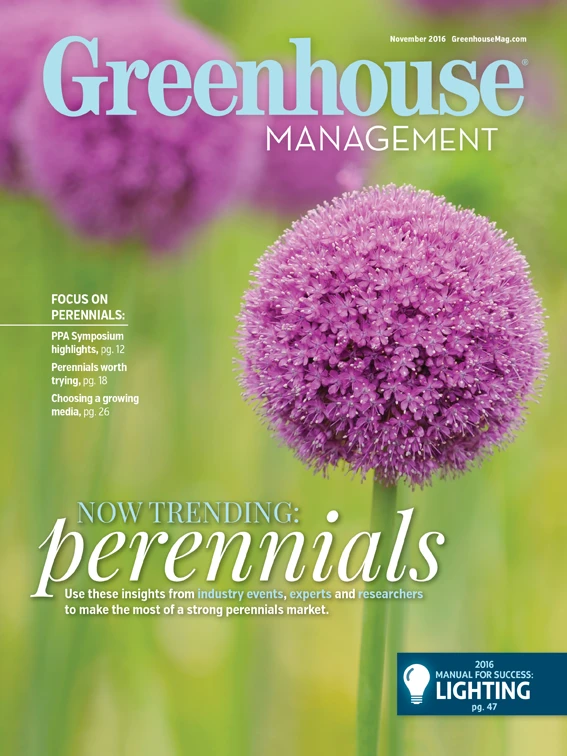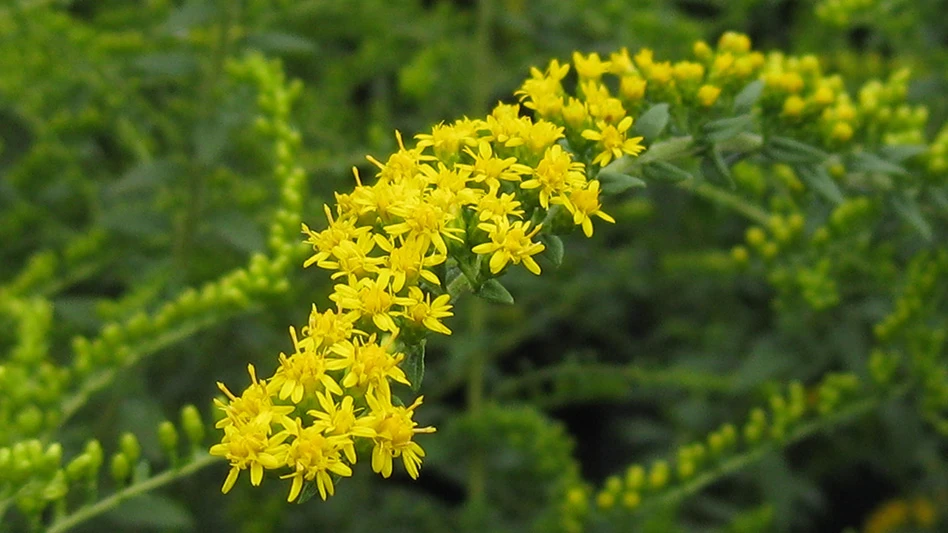
The spacing of lamps in the greenhouse is strongly dependent on the purpose of the lamp, whether they are for photoperiodic or photosynthetic lighting. For photoperiodic lighting (used in greenhouses to regulate the duration of the light, or photoperiod), plants should receive at least 1 to 2 µmol·m-2·s-1 (approximately 10 foot-candles) of light in order to adequately promote or inhibit flowering in plants with short or long day responses. Therefore, growers should be testing the instantaneous light intensity as they are installing low-intensity lamps (e.g., compact fluorescents (CFL), incandescent (INC), light emitting diodes (LEDs)) in their greenhouse.
As a rule of thumb, 100-watt incandescent lamps should be mounted 6 to 8 feet apart in a matrix. 60-watt INC lamps should be spaced closer together (4 to 5 feet apart). Growers may also consider installing a mixture of incandescent and CFL for photoperiodic lighting. Growers who choose to install a combination of lamp types should consider alternating between 100-watt incandescent and 25-watt fluorescent lamps, 6 feet apart from each other in order to ensure rapid and uniform flowering (Fig. 1). Michigan State University (MSU) Extension does not recommend installing all compact fluorescent lamps for photoperiodic lighting. The compact fluorescent lamps, which have a high red to far red ratio, delay flowering in some plant species and cultivars such as ‘Purple Wave’ petunias.
Growers may also consider using moving lamps such as HPS lamps or boom lighting for photoperiodic lighting. These lamps emit high-intensity light where the beam of light moves over the plants to create a sufficiently short night (or long day) in order to control flowering responses. Some greenhouse growers use HPS lamps with rotating reflectors (e.g., Beamflicker) that move the beam of light back and forth over the crop about once every minute.
Another MSU trial found that one 600-watt HPS lamp with a rotating reflector controlled the flowering of long-day plants up to 35 feet away from the lamp. In order to inhibit flowering of short-day plants, the HPS lamps would need to be a maximum of 20 to 25 feet apart. Another type of moving lamps is boom lighting, where the high-intensity lamps are mounted on the irrigation boom. They should be placed 2 to 5 feet above the crop and the lamps and booms should be operated for 4 to 6 hours during the night for night interruption lighting. Growers should aim to illuminate plants at least once every 20 to 30 minutes in order to adequately promote flowering in long-day plants.
High-intensity lighting should also be installed based on the light intensity at plant height. In addition to light intensity, light duration is extremely important when considering the spacing of high-intensity lamps. For example, if the instantaneous light intensity is 50 µmol·m-2·s-1, leaving the lamps on for 12 hours will add only 2.2 mol·m-2·d-1 while leaving them on for 18 hours will provide the plants with 3.2 mol·m-2·d-1. If you double the instantaneous light intensity to 100 µmol·m-2·s-1, 12 hours of lighting will provide plants with 4.3 mol·m-2·d-1 and 18 hours of lighting will provide 6.5 mol·m-2·d-1. In northern latitudes, where the light levels can sink to as low as 2 mol·m-2·d-1 during the winter months early in the production season, the lamps that provide 100 µmol·m-2·s-1 of light will be very beneficial in reaching the “target” daily light integral: 10 mol·m-2·d-1. The quality of plants is greatly reduced when plants receive less than 10 mol·m-2·d-1. As growers look to install supplemental lighting, the lighting manufacturer should be able to generate a lighting map which provides information on light intensities throughout the greenhouse. This lighting map is essential for deciding the spacing of high-intensity lighting in your greenhouse structure.

Explore the November 2016 Issue
Check out more from this issue and find your next story to read.
Latest from Greenhouse Management
- The thrips battle plan
- Pennsylvania Horticultural Society shares top gardening trends from 2025 Philadelphia Flower Show
- California Spring Trials 2026 dates announced
- Les Evans promoted to DRAMMwater segment manager, Al Zylstra to retire
- Hoffmann Family of Companies to acquire N.G. Heimos Greenhouses
- The Growth Industry Episode 3: Across the Pond with Neville Stein
- Southern Garden Tour sets 2025 dates for trial garden open houses
- GIE Media Horticulture Group wins five regional 2025 Azbee Awards of Excellence





